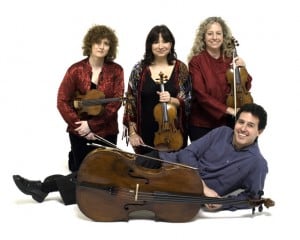 Ives Quartet (IQ) salons offer a heady mix of intelligent conversation about music, interspersed with more music. There’s nothing quite like these events anywhere in the Bay Area. They’re targeted at the same crowd who so enthusiastically responded to Anthony Tomassini’s “Top Ten” in the New York Times some months back: the educated, enthusiastic listener who hungers to learn more. Thanks to the IQ, we all listen smarter.
Ives Quartet (IQ) salons offer a heady mix of intelligent conversation about music, interspersed with more music. There’s nothing quite like these events anywhere in the Bay Area. They’re targeted at the same crowd who so enthusiastically responded to Anthony Tomassini’s “Top Ten” in the New York Times some months back: the educated, enthusiastic listener who hungers to learn more. Thanks to the IQ, we all listen smarter.
As the title indicated, this salon was devoted to discussing Mozart, Haydn and the 1780s. The 1780’s were a fecund period for string quartets, giving rise to much of the standard repertoire for the same. The two years between 1785 and 1787 were particularly remarkable because they brought forth Haydn’s Opus 50 (also known as the Prussian Quartets,) and Mozart’s String Quartet in D Major, K. 499 (known as the Hoffmeister). Just as he did for the IQ salon back in September, musicologist Derek Katz from UC Santa Barbara joined the group to elaborate upon the nature of the string quartet, with particular attention to Haydn’s B flat major quartet and Mozart’s Hoffmeister.
Katz noted these works were composed in Vienna and remarked that just as Vienna was strange, the nature of string quartets was strange. Elaborating further, he explained that unlike London and Paris, where music was beginning to leave the manor and enter the performance hall, Vienna was hardly the hub of the musical world. It might be the center of the empire, but Vienna had limited access to music publishing world. In Vienna, composers such as Haydn were servants for landed families, composing for particular functions. It was only later that musicians made the transition from court servants to entrepreneurs. Quartets thrived in this environment. Those written in London and Paris, tended to give themselves up too easily. Typical of these are works by Ignaz Joseph Pleyel, who was writing in London. However, in the rarified Viennese air, there was little division between musician and audience. Here, the quartet developed as a conversation – played in rooms not unlike the IQ salon, albeit for even smaller audiences.
Turning to the first movement of the Haydn, the IQ performed with their usual consummate flair. With impeccable articulation, each of the three figures made their rounds from one instrument to another, each interwoven with the other. Perfectly balanced and paced, the IQ’s performance embodied Goethe’s definition of a string quartet being a “conversation between four rationale people.” For this point in time, there was no better place in the universe than ten feet away from Susan Freier, Stephen Harrison, Bettina Mussumeli, and Jodi Levitz. These salons offer the listener an ear up, as it were, on performances that might otherwise sound excellent, but take on a transcendental quality in such close range.
Deconstructing the Mozart String Quartet in D Major, Katz explained how the minuet and trio of this work “is just too wacko,” defeating traditional expectations. I wish Katz could have elaborated here, requiring the musicians to play particular irregular elements, as he did with the Haydn, because I only followed about a fifth of his explanation. However, this was a minor distraction.
The only real disappointment is that we have to wait until March for the next Salon, which will be about Schubert’s “Death and the Maiden.”



